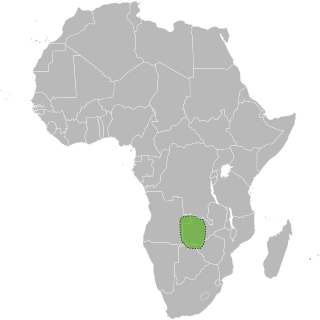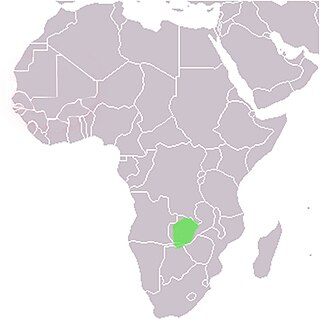
The Lozi people, also known as Balozi, are a Bantu-speaking ethnic group native to Southern Africa. They have significant populations in Angola, Botswana, Namibia, Zambia, and Zimbabwe. The Lozi language, Silozi, is used as the formal language in official, educational, and media contexts. The Lozi people number approximately 1,561,900.

Barotseland is a region between Namibia, Angola, Botswana, Zimbabwe including half of north-western province, southern province, and parts of Lusaka, Central, and Copperbelt provinces of Zambia and the whole of Democratic Republic of Congo's Katanga Province. It is the homeland of the Lozi people or Barotse, or Malozi, who are a unified group of over 46 individual formerly diverse tribes related through kinship, whose original branch are the Luyi (Maluyi), and also assimilated Southern Sotho tribe of South Africa known as the Makololo.

The Kololo or Makololo are a subgroup of the Sotho-Tswana people native to Southern Africa. In the early 19th century, they were displaced by the Zulu, migrating north to Barotseland, Zambia. They conquered the territory of the Luyana people and imposed their own language. The combination of Luyana and Kololo languages gave rise to the current Lozi language spoken by the Lozi people, descendants of the Luyana and nearby tribes. In 1864, the Kololo kingdom was overthrown and some chiefs moved to Chikwawa District, Malawi, with David Livingstone.

The Kingdom of Kongo was a kingdom in Central Africa. It was located in present-day northern Angola, the western portion of the Democratic Republic of the Congo, Southern of Gabon and the Republic of the Congo. At its greatest extent it reached from the Atlantic Ocean in the west to the Kwango River in the east, and from the Congo River in the north to the Kwanza River in the south. The kingdom consisted of several core provinces ruled by the Manikongo, the Portuguese version of the Kongo title Mwene Kongo, meaning "lord or ruler of the Kongo kingdom", but its sphere of influence extended to neighbouring kingdoms, such as Ngoyo, Kakongo, Loango, Ndongo, and Matamba, the latter two located in what is Angola today.

The Ambundu or Mbundu (Mbundu: Ambundu or Akwambundu, singular: Mumbundu are a Bantu people who live on a high plateau in present-day Angola just north of the Kwanza River. The Ambundu speak Kimbundu, and most also speak the official language of the country, Portuguese. They are the second biggest ethnic group in the country and make up 25% of the total population of Angola.
The Litunga of Barotseland is the King of the Barotse people. The Litunga resides near the Zambezi River and the town of Mongu, at Lealui on the floodplain in the dry season, and on higher ground at Limulunga on the edge of the floodplain in the wet season. The Litunga moves between these locations in what is known as the Kuomboka ceremony.
Mbunda is a Bantu language of Angola and Zambia. There are several dialects: Katavola, Yauma, Nkangala, Mbalango, Sango, Ciyengele ("Shamuka"), and Ndundu, all of which are closely related. Mbunda was one of six languages selected by the Instituto de Línguas Nacionais for an initial phase to establish spelling rules in 1980 to facilitate teaching in schools and promoting its use.

Sipopa Lutangu was the leader of the Lozi revolution and later a Litunga (king) of the Lozi people. He ruled from 1864 to 1876.

Mwanawina I was a Litunga of Barotseland in Africa.
Prince Mbanga was an African nobleman, the first Chief of Nalolo. His wife was named Notulu.
Mulena Yomuhulu Mbumu wa LitungaNgalama was a High Chief of Lozi people in Barotseland Zambia, Africa.

Mulena Yomuhulu Mbumu wa LitungaYubya I was a High Chief or King of Barotseland in Zambia, Africa, one of the sacred Lozi chiefs.

Mulena Yomuhulu Mbumu wa LitungaMwananyanda Liwale was a King of Barotseland in Zambia, very unpopular ruler.

Mulena Yomuhulu Mbumu wa LitungaSelumelume Muimui was a Chief of Barotseland in Africa.
Mulena Yomuhulu Mbumu wa LitungaMubukwanu was a High Chief of the Lozi people, King of Barotseland in Africa. He quarrelled with his brother Silumelume.
Akufuna Tatila was a Litunga, Chief of the Lozi people of Barotseland in Africa, but he ruled for a very short time and his power was weak. His full title was Mulena Yomuhulu Mbumu wa Litunga.
The Mbunda or Vambunda are a Bantu people who, during the Bantu migrations, came from the north to south-eastern Angola and finally Barotseland, now part of Zambia. Their core is at present found in the south-east of Angola from the Lunguevungu river in Moxico to the Cuando Cubango Province.
Mwene Chitengi Chiyengele was a Mbunda king who led his people from south-eastern Angola to Barotseland in western Zambia around 1824. The Mbunda were skilled game hunters and fighters using bow and arrow. They were welcomed by King Mulambwa of the Aluyi of Barotseland, now Western Zambia.

The Mbunda Kingdom, sometimes called the Kingdom of Angola or Mbundaland, was an African kingdom located in western central Africa, in what is now southeast Angola. At its greatest extent, it reached from Mithimoyi in central Moxico to the Cuando Cubango Province in the southeast, bordering Namibia.








